Webcam Mediated Communication
Description
Week 8: March 11 – 17
For the last remote class, we will discuss the idea of Webcam mediated communication: how the local and remote are collapsed through audio-visual communications and actions in the third space. We will also prepare for the work by Helen Varley Jamieson with a virtual workshop, exploring and developing the performance to be created and performed for the upcoming Art of the Networked Practice | Online Symposium.
Assignments
Due Next Week: March 18 (Final Project Review)
1 – Project Hyperessay II: Technical Realization
For the second installment of the Project Hyperessay, include a technical description with any sketches, drawings, photographs, and media examples you have done, which help articulate the technical elements of the work, as well as any specific software and/or hardware that is required for the project.
See Project Hyperessay in Project Assignments for additional information.
2 – Presentation for Group Review
Based on the Project Hyperessay II Technical Realization, prepare a Powerpoint presentation, or Web page of media, for an approximately 5 minute prsentation.
3 – Performance Exercises & Creative Writing
Mobile Cam Exercise:
Work in pairs to have a networked conversation from different places via Adobe Connect while on the move: walking, negotiating doors, stairs, in public transport, campus bus system, or a car (but NOT while you’re driving!), etc. Wherever you go, think about whether this could be part of your location & journey for the performance. Keep in mind the bandwidth of the area you are in, what happens when it drops out, and how to quickly and easily get back on-line.
Two purposes of this exercise: one is to become really familiar with Adobe Connect on your mobile device – so that you could do it in your sleep. The other is to really think about what you are sending in your stream (audio & video). Explore the frame of the webcam – what you choose to show or not show, what’s in the background, what happens when you move quickly or slowly, how the changing light affects the image. Try doing some close-ups of strange or ordinary things; follow people’s feet; try to show no people, or always with a person in the shot. Think also about sounds – what does your mic pick up? can you hold the mic close to things e.g. doors for their sounds, & what does this mean for the image? What is the quality of audio coming from your partner like?
Be sure you have Installed the Adobe Connect Mobile app for iOS or Android. See the Symposium Performance Project Page for information about the project and for help using the Adobe Connect Mobile app.
Blog Post:
(1) When you have completed your Adobe Connect exercises, create a new blog post and document the experience, what happened, what succeeded, what failed, what you need to be thinking about to make Web cam an instrument for performance. Take screenshots with your phone to document the exercises visually (press home button / on-off button simultaneously).
(2) Write a short text that responds to the title of the work: “we r here[now]” It can be poetic or critical/theoretical or factual or playful or whatever comes to mind. How does this title suggest an ending for the performance? What can you imagine as a good ending? (pretend you have no financial or technical constraints & let your imagination go wild). Next week these texts will be used for experimental collaborative writing in class and ultimately some of the texts may be woven into the performance.
Outline
Hyperlecture Week 8: Webcam Mediated Communication
Works for Review
Jennifer Ringley, Jennicam, (1997)
Why live under the eye of the lens? Why expose our everyday lives on the Internet? Is it a critique of the erosion of privacy, an exercise in voyeurism, a need for recognition? Here is a sequence of images from JenniCam (now only accessible through the Internet Archive Wayback Machine), a pioneering project by Jennifer Ringley in which for seven years, she opened up her life to the Internet via Webcam.
Stills from the JenniCam project:

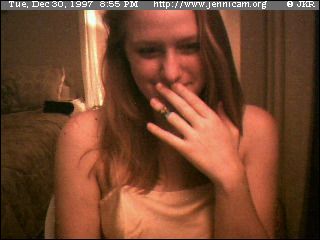
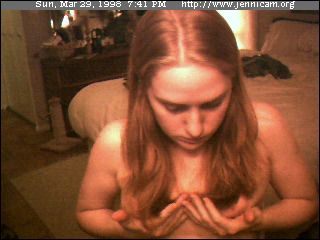
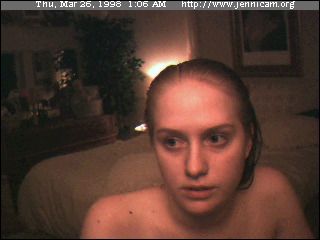
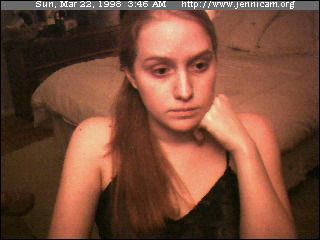
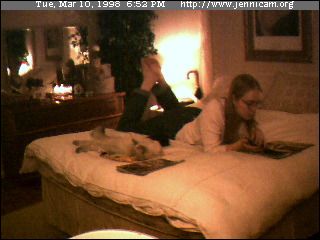
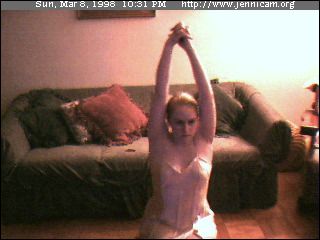
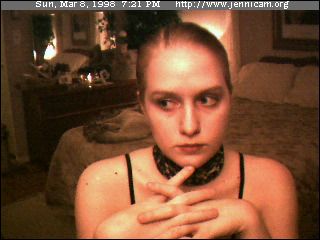
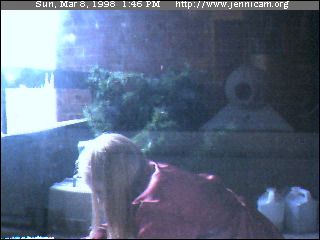
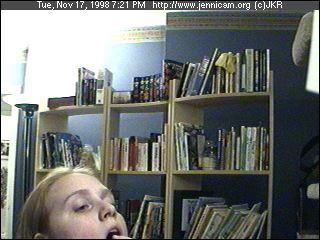
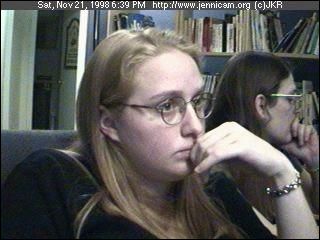
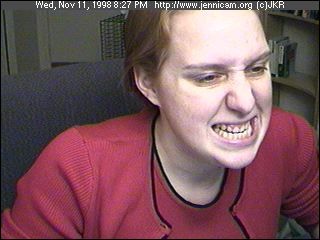


Annie Abrahams, The Big Kiss, 2007
French performance artist Annie Abrahams uses webcam technology to unite participants in a shared electronic space. In this work, the two performers attempt to kiss through the network. Despite physical separation, there is a sense of intimacy in the telematic embrace. We ask the question: are we “alone together,” or are we able to form meaningful and deeply human connections through networked interaction and performance.
On October 10, from 7pm to 10 pm, Over The Opening is pleased to present The Big Kiss, a performance installation by Annie Abrahams. You are invited to participate in the creation of a communal kiss. OTO N6th Street, Brooklyn New York.
What’s contact in a machine mediated world? What’s the power of the image? How does it feel to kiss without touching? Does the act change because we see it? What does it mean to construct an image with your tongue? And is there still desire? Does the act provoke it? What’s contact in a machine mediated world?
Machine mediated kissing in a performance = drawing with your tongue = taking pleasure, while constructing an image = a way to be superaware of the other = never totally abandoning yourself = ???????? = not at all like real kissing, it’s better! This might be a female view point.
Helen Varley Jamieson, Make-Shift (2012)

make-shift is an intimate networked performance and discussion event that re-imagines the private actions of our domestic lives as multiple, interconnected and with global consequences. Each event takes place simultaneously in two ordinary houses connected through an online interface, accessible through the Live Stage link on this website to anyone around the world with internet access. Not only telematically connecting artists in two different spaces nor working in a purely online chat/graphic format: make-shift combines the two, creating real-time dialogue between houses and people across the globe. – See more
I recommend watching the first 10 or 15 minutes of the video below get an idea of this documentation, which is a version of the work similar to the online documentation, in that is unites two physical spaces spaces as well as an online audience, but is different in terms of its content and choice of materials and subject matter. Here the desktop unites multiple spaces and individuals in the third space to create a free form dialogue, exchange, a “make-shift” dialogue and engagement. It seems that anything is possible, a spontaneous social experiment brought together via Webcam mediated communications, audio-visual media and chat.
Updates on Final Projects
Everyone should be thinking about their work in more detail and preparing for the second part of Project Hyperessay: Technical Realization, due next week, Wednesday, March 18th. We will discuss the projects in detail when I return to Singapore for this class. For this session I would like everyone to show an example or sketch of the work-in-progress, whether it be a video, images, sounds, online tests: an element of the work that will give us a clear idea of how the project is taking shape. You may assemble your work in a Powerpoint presentation, present from your Website, or show individual clips and/or material. Each student will present for approximately five minutes each followed by short discussion.
Readings
1. Steve Dixon, Webcams: The Subversion of Surveillance (pg. 443-455), Digital Performance, 2007
What is meant by the notion that the Webcam lends a degree of authenticity to what is being viewed. Like reality tv, it is perceived as real-time in the moment, without a past or a future, it represents the Now.
“Webcams essentially purport to be the virtual performances of real life.”
As separate from theater, the Webcam is about reality, not fiction, not the suspension of disbelief, but life as it unfolds in clock time.
“JenniCam as a sort of window into a virtual zoo.”
Does this statement imply that the subject of a Webcam “documentary” is presented like an “animal” on display? By stripping away privacy are we reducing the life of the subject to be merely on display? What are the ramifications of JenniCam, or any of us subject to self-imposed surveillance.
“When Ringley was not visible the set was ever-present.”
Does the watchful, unblinking eye of the Web camera represent a presence that is like itself: always there, always real, never ceasing? Essentially, there is no intermission in life (except perhaps sleep).
Is JenniCam an expression of feminism, defiance, risk-taking, and self-determination, or is it an enticement for the male gaze, a form of exhibitionism that led to the explosion of pornographic sites on the Internet.
2. Annie Abrahams, Trapped to Reveal – On webcam mediated communication and collaboration, Journal for Artistic Research
In a society where authenticity and privacy become endangered it is important to find ways to access our vulnerabilities and doubts, to make them public, to cherish our messy side.
Does this provide us some insight into JenniCam? Is there a contradiction between the endangerment of privacy and making everything public?
The Big Kiss performed with Mark River (of MTAA) in New York (2007) [2] might have looked like an intimate performance, but it was closer to a “drawing à deux” session than to a real kiss, even if it did awaken intimate feelings just as drawing a kiss-on paper might have done.
Helen Varley Jamieson has been developing a practice of cyberformance – live performance on the internet – for over a decade. Make-Shift [11] made together with Paula Crutchlow is her last cyberformance project where she uses webcams in an intricate play between dispersed audiences.
When studying biology (doctoral degree in 1978) I had to observe a colony of monkeys in a zoo. I found this very interesting because I learned something about human communities by watching the apes. Nowadays I observe behaviour on the internet with the same curiosity and interest.
Maybe a performance is for me, as an artist, what an article is to a scientific researcher –that is, a way to make public, to share, something that you think is important for other people to know about or to feel.
The performance works of Annie Abrahams are research experiments to better understand human communication in mediated conditions. This is fundamental to our upcoming project with Helen Varley Jamieson. Think about how the performance is research into Webcam mediation and how it effects our sense of distance, connection, relations to others.
The projects situate a condition of lonely togetherness, of life constructing a commonality, of being together and sharing this condition of co-responsibility, of scripted auto-organisation.
Are we in fact “alone together” when engaging in mediated forms of communication?
In my web performances the performers have so much to do and so little control that their communication both suffers (becomes more difficult) and prospers (becomes more honest) due to these conditions.
Workshop with Helen Varley Jamieson
Helen Varley Jamieson is a writer, theatre practitioner and digital artist from New Zealand, currently based in Munich, Germany. She completed a Master of Arts (Research) at Queensland University of Technology (Australia) in 2008, investigating her practice of cyberformance (live performance on the internet), and works as an independent artist and researcher. Helen is one of the founders of UpStage, an artist-led open source online platform for cyberformance, and has collaborated in the organisation of six online festivals of cyberformance using UpStage (2007-12). In 2012 she was one of the organisers of the CyPosium, a one-day online symposium about cyberformance and networked performance, after which she co-edited with Annie Abrahams CyPosium – the book, published in 2014 by Link Editions.
Live Webcam Cyberformance: New work created by Helen Varley Jamieson, and performed by NTU students. Viewable in the ADM Library Screening Room, the ADM Main Lobby, and via Adobe Connect.
we r now[here] is a cyberformance about nowhere and somewhere: the “nowhere” of the Internet becomes “now” and “here” through our virtual presence. Approaching the virtual somewhere from a physical nowhere, we glimpse streets, public transport, corridors, doorways – physical representation of data packets and pixels on the move – until the audio-visual streams converge into a single “now-here” in the somewhere of the Internet.
Student performers: Huang Pei-Sheng (Frank), Quek Ming Jie (MJ), Ruzana Abdul Rahim, Tao Sheng (Tommy), Beverley Ng, Hannah Lerner, Mercik Bridget Tyler, Prakash Perumal Haridas, Eugene Soh, Ashley, Sharanya Pillai Lai, Diana Toh
Helen’s Notes for Today’s Workshop
- Concept: Helen will outline the concept for “we r now[here]”, followed by discussion with the students for their response and additional ideas.
- Tech: check that everyone has Adobe Connect on a mobile device, whether some have data plans and some not, headphones, mics, how to mute/unmute and stop/start cam; any other tech issues.
- Exercise: working with webcams to create composite images – using objects, colours, paying attention to what is in the background, etc. and also to sounds.
- Final Scene: how do we want the performance to end – where do we all “arrive”? Discuss ideas, try out if possible (bearing in mind that the students aren’t in the space & we don’t have the audience there).
- Next Week: Confirm timetable & plan for the next workshop on 18th of March, 9:30 – 10:30 PM SGT:
- Mobile Cam Exercise for next week: work in pairs or small groups to have a networked conversation via Adobe Connect while walking, negotiating doors, stairs etc. Explore the frame of the webcam – what you choose to show or not show, what’s in the background, what happens when you move quickly or slowly, how the changing light affects the image. Think also about sounds – what do your mics pick up? can you hold the mic close to things e.g. doors for their sounds, & what does this mean for the image? Take a screenshot and create a post with answers to the above questions. Be prepared to discuss in class.
- location: students on campus
- explore area: foyer, theatre; look for dead spots in the network, get familiar with the space & how the audience can be led/drawn from one space to another
- discuss: come back together and discuss observations from the exercise
- refine: test out ideas for audience involvement and climax/finale
- media: discuss audio and any other media that we might want to use in the performance
My notes from my meeting with Helen (March 9): The performance will be a journey from one space to another. In the “local space” the audience at ADM will be led from the Main Lobby to the Library Screening Room by performers with active mobile devices, drawing the audience into the work as they are projected on screens both in the Lobby and in the Screening Room, visible to the online audience. In the “remote space,” gradually over time, the performers will gather together from their various locations: from Singapore to Boston & Toronto.
Review Assignments for Next Week
1 – Project Hyperessay II: Technical Realization
For the second installment of the Project Hyperessay, include a technical description with any sketches, drawings, photographs, and media examples you have done, which help articulate the technical elements of the work, as well as any specific software and/or hardware that is required for the project.
See Project Hyperessay in Project Assignments for additional information.
2 – Presentation for Group Review
Based on the Project Hyperessay II Technical Realization, prepare a Powerpoint presentation, or Web page of media, for an approximately 5 minute prsentation.
3 – Preparation for Next Week’s Performance Workshop
- Install Adobe Connect Mobile app for iOS or Android
- Review information about the Adobe Connect Mobile app
- Practice mobile app exercise assigned by Helen (TBA)